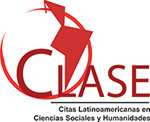Biofertilizantes una alternativa ecológica para la agricultura frente al cambio climótico en el Ecuador
DOI:
https://doi.org/10.23857/dom.cien.pocaip.2017.3.4.oct.75-88Palabras clave:
Cambio climático, agricultura, bio-fertilizante, micorrizas.Resumen
Los efectos negativos del cambio climótico en la agricultura podrían ser significativos en países en desarrollo como Ecuador. Estos efectos negativos en la agricultura podrían generar dos problemas diferentes en Ecuador. El primero podría ser el impacto negativo del clima en el cultivo, lo que ocasionaría la pérdida de cosecha. El segundo podría ser un impacto negativo en la economía ecuatoriana porque este sector representa la segunda fuente de ingresos mós grande para el país. Para abordar este problema mundial y sus posibles impactos en la industria agrícola ecuatoriana, se realizaron pruebas de campo para analizar parametros como el crecimiento radicular y altura de planta mediante el uso de bio-fertilizantes en el cultivo de frejol caupí (Vigna unguiculata L.). El objetivo es dar a conocer alternativas sustentables y sostenibles para el ambiente con la finalidad de reducir el uso de fertilizantes y químicos en la industria agrícola del Ecuador logrando así reducir los impactos del cambio climótico.
Citas
Barker, T. (2003). Representing global climate change, adaptation and mitigation. Global Environmental Change, 13(1), 1-6. doi: 10.1016/S0959-3780(02)00085-7
Berg, A., de Noblet-Ducoudrí©, N., Sultan, B., Lengaigne, M., & Guimberteau, M. (2013). Projections of climate change impacts on potential C4 crop productivity over tropical regions. Agricultural and Forest Meteorology, 170, 89-102. doi: 10.1016/j.agrformet.2011.12.003
Berg, A., Sultan, B., & Noblet-Ducoudrí©, N. (2010). Including tropical croplands in a terrestrial biosphere model: application to West Africa. Climatic change, 104(3-4), 755-782. doi: 10.1007/s10584-010-9874-x
Calzadilla, A., Rehdanz, K., Betts, R., Falloon, P., Wiltshire, A., & Tol, R. S. (2013). Climate change impacts on global agriculture. Climatic change, 120(1-2), 357-374. doi: 10.1007/s10584-013-0822-4
Cline, W. R. (2007). Global warming and agriculture: Impact estimates by country: Peterson Institute.
Comission for Africa. (2005). Our Common Interest: Report of the Commission for Africa. London: Commission for Africa.
Elbehri, A., Genest, A., & Burfisher, M. E. (2011). Global action on climate change in agriculture: Linkages to food security, markets and trade policies in developing countries: Trade and Markets Division, Food and Agriculture Organization of the United Nations.
Hoffmann, U. (2011). Assuring food security in developing countries under the challenges of climate change: Key trade and development issues of a fundamental transformation of agriculture.
Jones, J. W., Hansen, J. W., Royce, F. S., & Messina, C. D. (2000). Potential benefits of climate forecasting to agriculture. Agriculture, Ecosystems & Environment, 82(1), 169-184. doi: 10.1016/S0167-8809(00)00225-5
Ludena, C., & Wong, S. (2006). Domestic support policies for agriculture in Ecuador and the US-Andean countries free trade agreement: an applied general equilibrium assessment. Paper presented at the American Agricultural Economics Association 2006 Annual meeting, Selected Paper, Long Beach, CA.
MAGAP. (2013). MAGAP presentó programa de inversion forestal, en cumbre internacional de medio ambiente. from http://www.agricultura.gob.ec
Marro, N., Lax, P., Cabello, M., Doucet, M., & Becerra, A. (2014). Use of the arbuscular mycorrhizal fungus Glomus intraradices as biological control agent of the nematode Nacobbus aberrans parasitizing tomato. Scielo, 57(5). Obtenido de http://www.scielo.br/scielo.php?script=sci_arttext&pid=S1516-89132014000500668.
Mertz, O., Halsnaes, K., Olesen, J. E., & Rasmussen, K. (2009). Adaptation to climate change in developing countries. Environ Manage, 43(5), 743-752. doi: 10.1007/s00267-008-9259-3
Morton, J. F. (2007). The impact of climate change on smallholder and subsistence agriculture. Proceedings of the National Academy of Sciences, 104(50), 19680-19685. doi: 10.1073/pnas.0701855104
Mukheibir, P. (2007). Qualitative assessment of municipal water resource management strategies under climate impacts: The case of the Northern Cape, South Africa: short communication. Water Sa, 33(4), 575-581.
Nambiza, W. (2013). Baseline study for the Climate Change, Agriculture and Poverty Alleviation (CCAP) initiative. from http://www.tfcg.org/pdf/TFCG CCAP Baseline Survey Report 2013 FINAL.pdf
Nelson, E., Kareiva, P., Ruckelshaus, M., Arkema, K., Geller, G., Girvetz, E., . . . Tallis, H. (2013). Climate change’s impact on key ecosystem services and the human well-being they support in the US. Ecol Environ, 11(9), 483-493. doi: 10.1890/120312
Ogallo, L. A., Boulahya, M. S., & Keane, T. (2000). Applications of seasonal to interannual climate prediction in agricultural planning and operations. Agricultural and Forest Meteorology, 103(1), 159-166. doi: 10.1016/S0168-1923(00)00109-X
Palanichamy, A. (2011). Global warming and impact on Indian agriculture and food production. Food Biology, 1(1).
Pandey, S. (2009). Adaptation to and mitigation of climate change in agriculture in developing countries. IOPscience, 8(1), 012020. doi: 10.1088/1755-1315/8/1/012020
Parry, M. L. (2007). Climate Change 2007: impacts, adaptation and vulnerability: contribution of Working Group II to the fourth assessment report of the Intergovernmental Panel on Climate Change (Vol. 4): Cambridge University Press.
Parry, M. L., Rosenzweig, C., Iglesias, A., Livermore, M., & Fischer, G. (2004). Effects of climate change on global food production under SRES emissions and socio-economic scenarios. Global Environmental Change, 14(1), 53-67. doi: 10.1016/j.gloenvcha.2003.10.008
Rosenzweig, C., & Parry, M. L. (1994). Potential impact of climate change on world food supply. Nature, 367(6459), 133-138. doi: 10.1038/367133a0
Smith, P., Martino, D., Cai, Z., Gwary, D., Janzen, H., Kumar, P., . . . O, S. (2007). Climate Change 2007-Mitigation of Climate Change: Working Group III Contribution to the Fourth Assessment Report of the IPCC: Cambridge University Press.
Solomon, S. (2007). Climate change 2007-the physical science basis: Working group I contribution to the fourth assessment report of the IPCC (Vol. 4): Cambridge University Press.
Stringer, R. (2001). How Important are the Non-traditional Economic Roles of Agriculture in Development? : Centre for International Economic Studies.
Stringer, R., & Pingali, P. (2004). Agriculture's Contributions to Economic and Social Development.
Toulmin, C., International African, I., Royal African, S., & Social Science Research, C. (2009). Climate change in Africa. New York; London: Zed Books in association with International African Institute, Royal African Society, Social Science Research Council.
Viteri, A., & Cordero, E. V. (2012). Documento de Análisis del Sector Forestal en el Contexto de Adaptación y Mitigación al Cambio Climatico del Sector Uso del Suelo, Cambio de Suelo, y Silvicultura (Forestal) en el Ecuador. Ministerio del Ambiente, Repíºblica de Ecuador, Cordero, V., & Cuenca, P., 6, 5-7.
World Bank. (2008). World Development Report 2008: Focus F: Adaptation to and mitigation of climate change in agriculture. from http://go.worldbank.org/C3TCZPDAJ0
World Bank. (2014). Ecuador dashboard: impacts & vulnerabilities. from http://sdwebx.worldbank.org/climateportalb/home.cfm?page=country_profile&CCode=ECU&ThisTab=ImpactsVulnerabilities
Descargas
Publicado
Cómo citar
Número
Sección
Licencia
Authors retain copyright and guarantee the Journal the right to be the first publication of the work. These are covered by a Creative Commons (CC BY-NC-ND 4.0) license that allows others to share the work with an acknowledgment of the work authorship and the initial publication in this journal.







